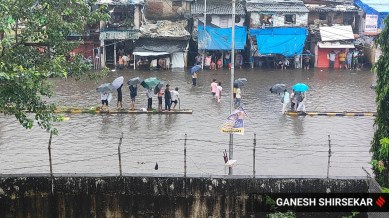Stay updated with the latest - Click here to follow us on Instagram
‘Climate change acts like a steroid, good network of early warning systems only way out’: experts as Mumbai records over 900 mm of rainfall in 4 days
Mumbai's Santacruz observatory recorded 944 mm of rainfall, and the Colaba observatory witnessed 461.8 mm of rainfall until August 19.

As Mumbai experienced one of the heaviest rain spells during August, climatology experts and scientists warned that such situations will become a more common occurrence in a warming world owing to climatic factors.
After a prolonged dry patch in July, a spell of extremely heavy rain returned to the city around August 16. Usually, July is one of the wettest monsoon months for Mumbai, while the intensity of rainfall usually decreases during August.
The India Meteorological Department (IMD)’s data show that Mumbai’s Santacruz observatory recorded 944 mm of rainfall, and the Colaba observatory witnessed 461.8 mm of rainfall until August 19. Meanwhile, between July 1 and July 31, the Santacruz observatory recorded 799.4 mm of rainfall, followed by 379.6 mm at Colaba.
“While there is a natural variability of monsoon weather systems, climate change acts like a steroid. The northward swing of the southwesterly monsoon winds is pumping massive amounts of moisture from the warm Arabian Sea into the northern Western Ghats. This northward swing is a combination of global warming, especially the warming over the Middle East, and the natural variability of the monsoon winds,” said Dr Raghu Murtugudde, Emeritus Professor, University of Maryland, and retired IIT Bombay professor.
The moisture supply for the summer monsoon rainfall along the west coast of the Indian subcontinent is mainly transported from the Arabian Sea. However, recent climate studies show that the Middle East is warming almost twice as fast as other inhabited parts of the world, which has been causing a dramatic increase in atmospheric instability in the Arabian Sea by thrusting moisture supplies northward. Therefore, the regions of Northwest India have been vulnerable to unprecedented rainfall.
“We all know that there has been a rise in temperature due to global warming. Secondly, the exponential warming of the Arabian Sea has increased the moisture influx along the West Coast, contributing to heavy precipitation. In this scenario, the only way out is to have a very good network of early warning systems, nowcast systems for urban flooding,” said Dr Subimal Ghosh, Institute Chair Professor, Department of Civil Engineering and Convener, Interdisciplinary Program in Climate Studies, IIT Bombay.
“More importantly, these advanced warning systems should be citizen-centric, which means the information should reach out to people so informed decisions can be taken. IIT Mumbai has created the Mumbai Flood Monitoring System, which helps in disseminating timely information to various stakeholders,” Ghosh added.
Last year, the Council on Energy, Environment and Water (CEEW) prepared a Thane City Action Plan for Flood Risk Management, which offered a framework for administrators to strengthen preparedness, response, and mitigation measures against urban floods.
Based on a detailed analysis of 52 years of rainfall data, the system analyses intensity-duration-frequency curves, estimates peak flow discharges, and creates a ward-wise urban flood risk index to identify vulnerable hotspots. However, a similar type of regulation is yet to be drafted for Mumbai.
The Brihanmumbai Municipal Corporation (BMC), in 2021, released the Mumbai Climate Action Plan (MCAP), which showed that 35 per cent of Mumbai’s population is vulnerable to waterlogging in the city.